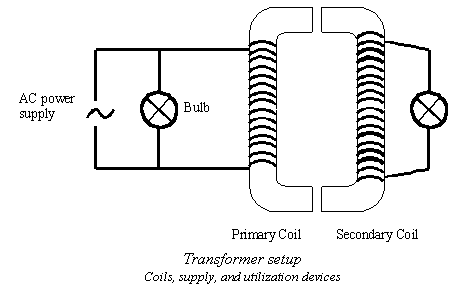|
This article
explains how to make a demonstration transformer. A
transformer is a device that converts one AC voltage to another.
A detailed description of how they work is given under transformer.
The purpose of this page is to give details of how a demonstration
transformer can be made very simply in a classroom in order
to teach the basic principles. Demonstrations similar to this
are usually performed in schools by pupils aged around 13
years old, under the supervision of a qualified science teacher.
You
will need
- Some
pieces of soft iron, preferably in a U shape but a cylinder
will do.
- Plastic-coated
wire
- Some
6 V mes bulbs (torch/flashlight bulbs) in a suitable bulb
holder
- Connecting
wire with 4 mm plugs
- Alligator
clips
- A 4
V AC power supply that is fitted with a 5 A trip switch
(IMPORTANT!)
Under
no circumstances should this homemade transformer be plugged
into home current.
Method

Strip
the insulation off the end of a long piece of copper wire
and wrap it 30 times around a cylinder of soft iron, to make
a solenoid. (If you can use a U-shaped piece of soft iron
then so much the better. You could also use two more short
pieces of iron attached to the two rod ends to help complete
the magnetic circuit.) Connect the ends of the wire into the
power supply using crocodile clips or other suitable connectors.
This is called a primary coil. Connect a 6 V bulb in parallel
with the primary coil.
Now take another long piece of wire. Strip the ends, and either:
wrap it around the same soft iron core 60 times or (even better)
if you have U-shaped soft iron cores; use a separate core
to put the 60 turns on. This is called the secondary coil.
You should now have two pieces of bare ends from the second
piece of wire. Connect them to a 6 V bulb so that you have
a loop that is independent of the power supply.
Turn on the power supply and (if applicable) join the two
u-shaped soft iron cores together. Be careful, the primary
coil will now be a powerful electromagnet.
Compare the brightness of the two bulbs. The secondary will
be much brighter.
Repeat with 15 turns on the secondary coil. This time the
secondary will be much dimmer.
This is a quick and dirty demo suitable to teach the basics
of transformers. Other experiments using professionally wound
coils and oscilloscopes are more suitable for more advanced
or older students.
|








